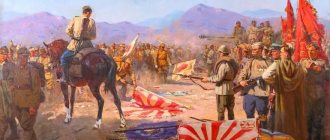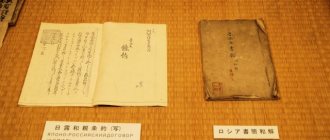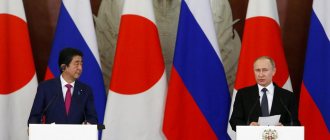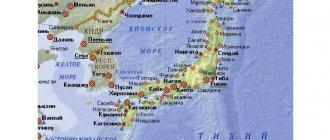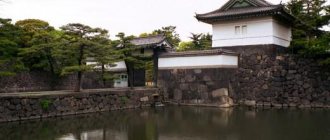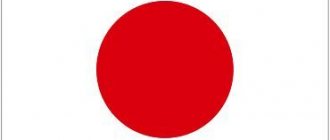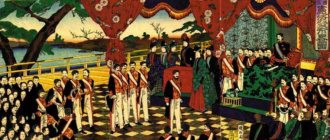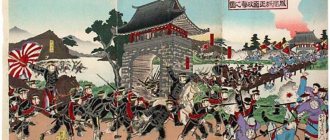Discussion of peace terms between the victorious countries and Japan took 6 years. The result of the work of Western diplomats involved in developing peace terms was the Treaty of San Francisco, created on the basis of the Anglo-American project. Since its provisions were rejected by the Soviet side, the conclusion of peace between Moscow and Tokyo was postponed for another 5 years.
Background
The terms of the future Soviet-Japanese peace treaty were agreed upon by the leaders of the Big Three even before the USSR and Japan began to fight against each other. At the beginning of 1945 in Yalta, the three powers entered into the following agreement: the USSR enters the war with Japan 2-3 months after the defeat of Germany, for participation in hostilities the islands of the Kuril ridge and the southern part of Sakhalin will be annexed to the territory of the Soviet Union. Stalin explained the last condition by saying that Soviet citizens must know what they are fighting for.
After defeat in World War II, Japan was occupied by Allied forces. Unlike Germany, Japan was not divided into occupation zones. American General MacArthur became the official commander-in-chief of the occupation forces. Since the Soviet side did not agree to place its soldiers under the command of an American, in fact, a purely American policy was pursued on Japanese territory.
The Western powers organized a trial of Japanese war criminals, participated in the development of a democratic constitution, and then began to rebuild the economy, develop cultural life, etc. Although representatives of the United States played a key role in the Japanese islands, America could not pursue its policy while ignoring public opinion and positions of their former allies. Therefore, the Yalta agreement was implemented in full: at the beginning of 1946, the Japanese repatriated their citizens from the lost territories, and the USSR issued a decree that these islands were now the property of the Soviet Union.
Despite the successful resolution of the issue of the status of the agreed territories, relations between Moscow and Washington gradually became tense. The Americans were extremely worried about the civil war in China that was coming to an end, where the victory of the Communists was becoming more and more obvious every day. Fearing the growing influence of the Soviet Union in the Far East, the United States took a number of measures.
Legacy of World War II
At the final stage of the war in Europe, at the Yalta Conference, the leaders of the anti-Hitler coalition states developed a joint plan for war with Japan. At the same time, it was decided that after the defeat of the imperial army, all the islands of the Kuril ridge would go to the USSR (“Crimean Agreement of the Three Great Powers on Far East Issues,” adopted on February 11, 1945).
On April 5, 1945, the USSR announced the denunciation of the Soviet-Japanese Neutrality Pact (1941; was supposed to be in force until April 1946). On August 9, 1945, the Soviet army began a military campaign in the Far East. Part of it was the Kuril landing operation (August 18 - September 1, 1945), as a result of which all the islands were liberated.
After losing the war, Japan signed the Act of Unconditional Surrender (September 2, 1945) and accepted the terms of the Potsdam Declaration of July 26, 1945. Japanese sovereignty was limited to the islands of Honshu, Kyushu, Shikoku and Hokkaido, as well as smaller islands of the Japanese archipelago (by decision of the Allies). All Kuril Islands were included in the Soviet Union by decree of the Presidium of the Supreme Soviet of the USSR (February 2, 1946). Within three years, most of the Japanese population was deported to Hokkaido.
Preparation of the San Francisco Peace Treaty
In the summer of 1945, in Berlin, the victorious countries entered into an agreement according to which all peace treaties with the Axis countries were to be prepared and signed with the mandatory participation of five foreign ministers:
- THE USSR;
- USA;
- Great Britain;
- France;
- China.
According to the authors of this agreement, such a condition would make it possible to avoid the conclusion of a separate peace in the future.
In 1947, the United States announced that it did not consider the Council of Five Ministers to be a sufficiently competent body to prepare a peace treaty with Japan. Instead, the United States proposed entrusting the development of the agreement to the Far East Committee, consisting of 11 countries and based in Washington. The Soviet Union tried to challenge this proposal, citing previously concluded diplomatic agreements, however, the US authorities preferred to ignore these appeals.
The conflict between the USSR and the United States over peace with Japan flared up against the backdrop of the intensifying Cold War. In this confrontation, Tokyo preferred to support America and even invited Washington to enter into a military alliance.
In 1950, the Korean War broke out, which became another reason for the rapprochement between America and Japan. In turn, the Soviet Union began to develop relations with the PRC, and in the same year the two powers signed a treaty of friendship and cooperation. A. Dulles went to Tokyo, whose tasks, in addition to developing peace conditions, also included establishing military cooperation with Japan. Soon a draft treaty emerged, drawn up by the US government without prior discussion with the USSR and China. The following year, the treaty was published, and its discussion began at a specially created conference in San Francisco.
Terms of the San Francisco Peace Treaty
The conference was attended by representatives of 52 countries, most of which were not at war with Japan. At the same time, the United States deliberately did not invite representatives from Mongolia, China, Vietnam and Korea to San Francisco, despite the fact that these states suffered from Japanese aggression and contributed to the victory on the Far Eastern front.
In its final form, the agreement included the following terms:
- the war is officially considered over;
- Japan must renounce its claims to Formosa, the Pescadores Islands, the Kuril Islands, the Paracel Islands, southern Sakhalin and the Spratly Islands, as well as its foreign policy interests in China and Korea.
- Japan loses rights to territories that were under its mandate, according to the decision of the League of Nations (that is, under its external administration);
- The world community recognizes Japan's sovereignty, as well as its rights to form its armed forces and enter into any collective security agreements;
- Within three months after the treaty enters into force, the occupation forces will be withdrawn from the territory of the Japanese Islands;
- Japan is obliged to recognize the verdict of the tribunal at which Japanese war criminals were convicted.
The document was signed by 48 countries. Deputy Minister of Foreign Affairs of the USSR A. Gromyko categorically refused to recognize the agreement. During his speech, he proposed adding a clause that would prohibit the establishment of foreign military bases in Japan. Gromyko also emphasized that the document does not contain any conditions regarding the demilitarization of Japan and the democratization of its policies, while the issue of reparations to countries affected by Japanese aggression is proposed to be resolved bilaterally without the intervention of international organizations, which is a clear concession to Tokyo. However, these comments remained ignored.
In addition, the document contained another trick that did not go unnoticed. Although the treaty recognized Japan's loss of rights to a number of territories, it did not indicate that these islands would be transferred to the Soviet Union and China.
As a result, the USSR, as well as representatives of Poland and Czechoslovakia who supported Gromyko’s position, did not sign the draft proposed by him.
According to Soviet and Asian diplomats, the Treaty of San Francisco did not contribute to Japan's transition to a peaceful foreign policy in the future. The terms of the treaty allowed Tokyo to once again begin building up its military contingent and move against its neighbors together with the armies of Western powers.
Klitin A.
On September 8, a peace treaty with Japan was signed in San Francisco, which summed up the results of World War II and laid the foundation for a new balance of power in Asia and in the world. A peace treaty with Japan was signed by 49 states, but it was not signed by such states as Mongolia (MPR), China (PRC), USSR, Vietnam (DRV), India and Burma, which made a significant contribution to the victory over Japan.
From the very beginning, the United States did everything to ensure that the USSR could not change the treaty in accordance with its interests during the conference meeting. The text of the treaty was prepared by Great Britain and the United States, and its terms were negotiated in advance by the United States and its allies. Countries chosen by the United States were invited to the peace conference in San Francisco, most of which were only formally involved in the war with Japan and were needed to create a majority loyal to the United States. Countries such as the MPR, DRV (Vietnam), China, and the DPRK were not invited to San Francisco at all. Therefore, during the conference, the USSR's proposals and amendments to the text of the treaty were not even put up for discussion. Then the First Deputy Minister of Foreign Affairs of the USSR (and in the future - one of the most talented foreign ministers in the entire history of Russia) Andrei Andreevich Gromyko called this agreement a separate deal between Japan and the United States. According to A. A. Gromyko, this agreement may provoke new conflicts, since it does not indicate in whose favor Japan is giving up these territories. He also sharply condemned the clause in the treaty that made it possible to place military bases of other states on Japanese territory by agreement, since he probably guessed which country’s bases would be located there.
The San Francisco Peace Treaty itself consisted of 7 sections and, in total, included 27 articles: peace, territory, security, political and economic regulations, claims and property, dispute resolution, final regulations. Under the terms of the 1951 San Francisco Peace Treaty:
1) Japan recognized the loss of its sovereignty over Taiwan and the Pescadores Islands, the Paracel Islands and the Spratly Islands, over the Kuril Islands and South Sakhalin and over Korea (on whose territory two independent states were formed). She also transferred the Ryukyu Islands (Nansei, Okinawa) to US custody.
2) Japan recognized all decisions of the Far Eastern Military Tribunal for war crimes both inside and outside Japan
3) Japan received the right to individual self-defense and the right to conclude collective security agreements
4) All foreign occupying forces were to withdraw from Japan within 90 days of the signing of the treaty. However, the treaty stipulated the possibility of stationing or maintaining foreign armed forces on Japanese territory under bilateral or multilateral agreements between Japan and other states
5) Japan has accepted the obligations set forth in Article 2 of the Charter of the United Nations
6) Japan renounced all its interests, rights and privileges in China, enshrined in the Beijing Protocol of December 7, 1901
Thus, the United States did everything to ensure that Japan never returned to its militaristic past. However, the Cold War was already in full swing, and with the loss of China, Washington desperately needed an ally in East Asia. Therefore, one of the main goals pursued by the United States at the conference in San Francisco was the desire of the United States to turn Japan into an allied state. Therefore, a few hours later, the Japan-US Security (Guarantee) Treaty was signed, which was the result of a compromise between Japan and the United States. Even earlier, the American occupation administration of MacArthur in Japan drew up a Constitution for Japan, according to which Japan did not have the right to create an army or declare war on any state. The Self-Defense Forces were created to defend the country from external enemies. According to the security treaty signed in San Francisco, Japan received security guarantees from the United States, American military units and military bases were located on its territory, and the American “nuclear umbrella” was supposed to protect Japan from any nuclear attack. In exchange for the presence of American military bases on its territory, Japan obtained from the United States an end to the occupation and the transfer of power to the Japanese government itself. Thus, the United States gained an ally in East Asia, and at the same time excluded the possibility of re-militarization of Japan. Also, by placing its military bases on Japanese territory, the United States ruled out the possibility of Japan joining the communist bloc. Japan also received certain benefits from the placement of American military bases: from that time on, it did not have to spend huge amounts of money on maintaining its own army, which was one of the reasons for the further intensive growth of its economy.
During the discussion of the San Francisco Treaty in the US Senate, a resolution was adopted containing the following clause:
“It is provided that the terms of the Treaty will not mean the recognition of Russia of any rights or claims in the territories that belonged to Japan on December 7, 1941, which would be detrimental to the rights and title of Japan to these territories, nor will any whatever provisions in favor of Russia in relation to Japan contained in the Yalta Agreement.”[1]
The signing of the San Francisco Peace Treaty and the US-Japan Security Treaty in 1951 laid the foundation for American security architecture in the Pacific region. Thanks to flexible, thoughtful policies and an alliance with Japan, the United States still has enormous influence in the dynamically developing Pacific region, which significantly strengthens its position in the world.
Sources:
- https://ru.wikipedia.org/wiki/%D0%A1%D0%B0%D0%BD-%D0%A4%D1%80%D0%B0%D0%BD%D1%86%D0%B8% D1%81%D1%81%D0%BA%D0%B8%D0%B9_%D0%BC%D0%B8%D1%80%D0%BD%D1%8B%D0%B9_%D0%B4%D0% BE%D0%B3%D0%BE%D0%B2%D0%BE%D1%80_(1951) // San Francisco Peace Treaty (1951)
- https://www.cultline.ru/archiv/s/4285 // San Francisco Peace Treaty
- https://dic.academic.ru/dic.nsf/enc_japan/670/%D0%A1%D0%B0%D0%BD // San Francisco Peace Treaty
- https://www.runivers.ru/doc/d2.php?SECTION_ID=7149&CENTER_ELEMENT_ID=137936&PORTAL_ID=7149 //From the speech of the First Deputy Minister of Foreign Affairs of the USSR A. A. Gromyko at a conference in San Francisco
- https://ru.wikisource.org/wiki/%D0%A1%D0%B0%D0%BD-%D0%A4%D1%80%D0%B0%D0%BD%D1%86%D0%B8% D1%81%D1%81%D0%BA%D0%B8%D0%B9_%D0%BC%D0%B8%D1%80%D0%BD%D1%8B%D0%B9_%D0%B4%D0% BE%D0%B3%D0%BE%D0%B2%D0%BE%D1%80_(1951)#.D0.93.D0.BB.D0.B0.D0.B2.D0.B0_I._.D0. 9C.D0.B8.D1.80//Text of the San Francisco Peace Treaty
- https://www.segodnya.ua/news/14065904.html
- A. D. Bogaturov “Great powers in the Pacific Ocean”
[1] https://ru.wikipedia.org/wiki/%D0%A1%D0%B0%D0%BD-%D0%A4%D1%80%D0%B0%D0%BD%D1%86%D0 %B8%D1%81%D1%81%D0%BA%D0%B8%D0%B9_%D0%BC%D0%B8%D1%80%D0%BD%D1%8B%D0%B9_%D0%B4 %D0%BE%D0%B3%D0%BE%D0%B2%D0%BE%D1%80_(1951)
Rating 2.50 (3 Votes)
Consequences
Almost simultaneously with the signing of the peace treaty, the United States and Japan entered into a bilateral agreement on the deployment of American armed forces in Japan. According to an official statement from Washington, the US military must protect peace and security in the Pacific region, so its presence there is necessary. Immediately after this, the United States dissolved the Far Eastern Commission.
In turn, the Japanese refused any economic and scientific cooperation with the Soviet Union. This rash decision later caused discontent among Japanese businessmen and industrialists.
Thus, the USSR and Japan formally remained at war with each other for several more years, until the signing of the Soviet-Japanese Declaration in 1956.


